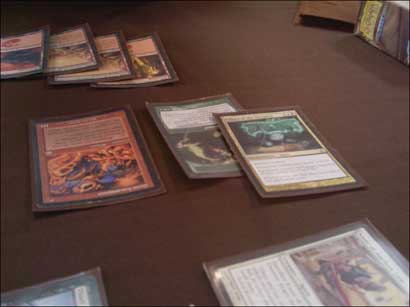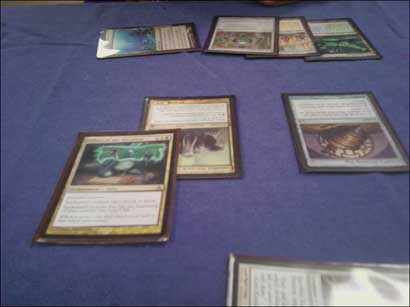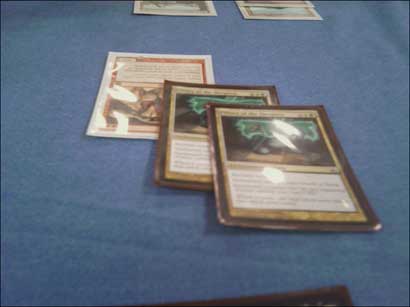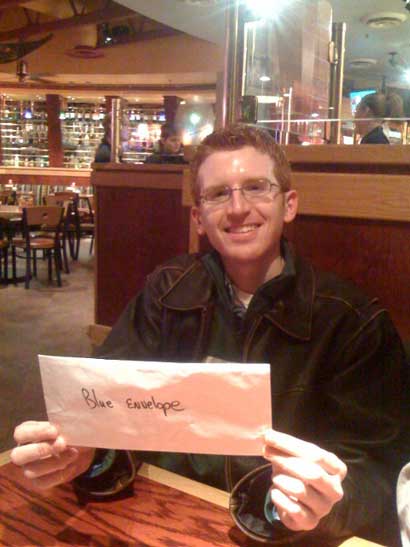By the way, I got second place at the PTQ in Cleveland on Saturday. I should have won both games in the finals, but I punted it di. Bleh. I’ll see you all in Kentucky. I fully expect to do better there than I did in Cleveland.
Me in the forums two weeks ago.
I went to Butler, Pennsylvania instead of Kentucky. I still say that I called it.
Project Hollywood
• 12/7: PTQ New York City (5-2, out after four rounds)
• 12/22: Winter King (8th, $75)
• 1/5: PTQ Roanoke, Virginia (6-2, out after six rounds)
• 1/6: Roanoke, Virginia Cash Tournament (5th, $75)
• 1/12: PTQ Cleveland, Ohio (2nd)
• 1/13: Cleveland, Ohio (Mox tournament) (4-2, out after five rounds)
• 1/26: PTQ Butler, Pennsylvania (1st)
• 3/15: Grand Prix: Philadelphia, Pennsylvania
I knew I wanted to play Next Level Blue again, but I wasn’t sure exactly what list to play. Gerry Thompson had been trying all kinds of crazy builds on Magic Online and keeping me informed about them, which was very nice of him. I played in Premier Events on Monday and Tuesday with two different versions of the deck and ended up X-2 each time, but I also either outright won or split in the finals of five Extended eight-mans with different lists.
Of course, when Friday night came I still didn’t have a final list I was happy with. I talked to Gerry over instant messenger and hammered out the final details with him. Most of that was me copying his list due to my forty or so sanctioned Magic Online matches with the deck being horribly dwarfed by his multiple hundreds, but I did come up with a nice sideboard card. Gerry was unhappy with Gaddock Teeg because Enduring Ideal and Blue/White Tron both have convenient ways to kill him, and when they do that they go back to full power with gigantic spells that you can’t stop. I made the throwaway suggestion that I wanted to play Ruination, but then realized that Global Ruin is fairly similar where you want that kind of effect. Enduring Ideal might get to keep a Plains and Tron decks will keep two Fountains, but that’ll be it. We ended up deciding to try it. Obviously neither of us ever boarded it in. Good beats.
I played this:
Creatures (7)
Lands (13)
Spells (40)

I want to publicly thank Gerry Thompson and Patrick Chapin for their help. Gerry helped me with lists and Patrick served as a spiritual coach of sorts; both were integral to my success so far this season. I should note that Gerry still thinks that my tweaks on his list are terrible. Craig tells me that you can find Gerry’s most up-to-date list in Patrick’s article today.
As far as I am aware, the differences between this and Gerry’s list are that Gerry has one more non-Island nonbasic land and fewer Thirst for Knowledges than me. I love a Thirst and I don’t like the idea of playing four Moxes without ways to dump them, and I think Cryptic Command is wonderful but often too slow. I also refuse to play any non-Island lands that aren’t strictly necessary, so I kept it down to the Tree and Ruins. With regard to specific card changes, Spell Snare is nice in that it never goes dead like Force Spike does, but Spike is far better in the early game so I’m on the fence about that one. Maindeck Threads is a concession to aggressive decks, and it’s better than Hierarch because it is cheaper and much more devastating when it hits. One Shackles is gone because the card is pretty slow, and three Threads mean that you steal plenty of creatures without all four Shackles.
Before I tell you about my matches, I have one somewhat unrelated story from the weekend. Earlier in the week, a truly miserable Benjamin Peebles-Mundy contacted me; he hated every deck in Extended and had no idea what to play. I suggested that he should play Ghost Dad, and he joked that he would if the PTQ didn’t cost $25. That seemed like a small price to pay for an awesome story, so I told him that I would cover the entry fee if he played Ghost Dad. He accepted my offer without a second thought. Ben ended 1-2, but it was all worth it because of these pictures:



He may not have won much, but I know he had far more fun doing that than he would have playing a normal deck, so mission accomplished.
JR Wade and Sam Stoddard were my traveling companions for the weekend. JR was originally going to arrive at my house at around midnight and sleep, and then we would leave for Butler at 5:30am. JR called me while he was driving up from Cincinnati with the bright idea to make the drive that night instead and get a hotel so that our five hours of sleep would be arranged closer to the tournament. A few quick phone calls to Sam and a Super 8 Motel later, and we were on the road to Butler. We arrived at 3:30am, slept until nine, and were ready to start battling.
My first round opponent was playing dredge, but his list was very strange. He had Life From The Loam, Green lands to fetch, and maindeck Leyline of the Void. It was also his very first PTQ, and he told me both that and that he felt a little intimidated by having to play against me. I kept a hand that had only Spell Snare for countermagic on the play, so naturally he played Putrid Imp on turn 1, then Careful Study, Breakthrough for zero, and Kill You Dead on turn 2. Okay, fine. In game 2, he played a Tombstalker on turn 2 after Putrid Imp into Golgari Grave-Troll. I naturally drew two of my Crypts so it was unlikely that he would be able to kill me with his graveyard, but Tombstalker was a nice way to dodge that. Happily, I had boarded in Sower of Temptation to burgle things like Akromas and big Grave-Trolls after eating their graveyard with Crypt, and his eyes got very wide when I took the Tombstalker with it. He had a Chain of Vapor to buy a turn, but then he didn’t have anything after that. He mulliganed in game 3, then very happily announced that he was keeping his six. I thought I was in trouble, but I needn’t have worried; his first turn was a tapped dual land, his second turn was land and Narcomoeba, and his third turn was just a second Narcomoeba. I’m not sure why he was so confident about this hand, but there it is. I had drawn two Crypts and a Trinket Mage, so I quickly put the game on lockdown and won.
I recognized my second round opponent from the Cleveland PTQ; he was playing an extremely odd Scepter-Chant-Loam-Doran deck at that tournament, and apparently it was good for him since he was playing it again here. Take your average Doran deck, cut all the non-Cabal Therapy discard, cut Eternal Witness, and add Scepters, Chants, and Life From the Loam with some cycle lands, and that’s about what he had. Both games were fairly easy. Midrange Green decks are very good matchups for me; Counterbalance stops most of their spells and the creature stealing effects take away their tempo. Both games were very similar; I just took all of his stuff and then killed him. Game 1 was interesting, however, in the sense that I took a few extra turns to kill him and I think that was correct. I had never found a Counterbalance and he had flipped an Isochron Scepter with Dark Confidant early in the game, so there was a threat of getting Chant-locked at any random time. After I had stabilized the board that was the only way I could possibly lose, so I spent a few turns digging for Engineered Explosives so that that wouldn’t stop me. I think it was worth it to make sure I didn’t get randomly locked out of the game when I was in control.
My third round opponent was playing the Spire Golem Mono-Blue deck. I would like to take a moment to say how I do not understand why anyone would be motivated to play that deck by anything other than card access concerns. Next Level Blue and Mono-Blue are literally the same deck except that Next Level Blue has Tarmogoyf and Counterbalance where the Mono-Blue deck has Spire Golem and terribly overpriced legends like Venser and Meloku. It’s actually a straight upgrade, and the mana isn’t any worse whatsoever. Now that that’s out of the way, I will talk about the games. I don’t actually remember all that much about them other than the fact that I won both; Blue mirrors are incredibly complicated and messy, and my notes aren’t helping. I do know that I had to Pithing Needle his Urza’s Factory in game 1, and that he mulliganed in game 2 and eventually died after bouncing all his lands to his Meloku when I used Shackles to take it. I would give you advice on how to play the Blue Shackles mirror, but it won’t do anything for you. Strategically speaking Counterbalance is pretty important to get into play, but other than that it’s almost all tactics that are extremely situation-dependent. If you are going to play Blue, practice the mirror a lot and you’ll figure it out.
Some important bits that may help you:
• If your opponent has a Counterbalance in play, your best opportunities to resolve important things are right after they shuffle their deck or Thirst. Whenever this happens, test them. You will be surprised how often something resolves.
• You will often win by getting a Tarmogoyf down on turn 1 or 2 and riding it all the way by protecting with Counterspells. This is the only way you will beat an opposing Counterbalance lock, and early beatdown is even better if you’re the one who locks them.
• Krosan Grip is really good at killing Counterbalance, but make sure to time it so that there is no chance of your opponent randomly having a three on top by accident.
A ghost from my past came for revenge in the fourth round. I played against the same physical copy of Green-White-Black Loam-Slide that I beat in the semifinals of the PTQ in Cleveland. The matchup may seem bad on the surface, but the only relevant cards in that deck are the Astral Slides. If you can stop those with Counterbalance or just actual counterspells, your opponent will never win a long game due to recurring Engineered Explosives to kill Decree of Justice tokens and Tormod’s Crypt to nerf Witnesses and Eternal Dragons. After that, you can just use Tarmogoyf and Shackles to clean up. Depending on circumstances, you may need to use Pithing Needle to nail their Treetop Villages. Academy Ruins is a key card for this plan, but you may be okay without it. Regardless, both games were long drawn-out affairs in which I slowly carved away his ability to do scary things and eventually killed him. I didn’t have Academy Ruins in the first one, but I managed to kill him with Trinket Mages anyway. Game 2 I had the Ruins, so it was much easier.
My fifth round paired me against a polite young man playing Affinity. My guess is that he was sixteen or seventeen, and it was his very first PTQ. It was impressive that he had gotten that far undefeated, but the wheels started to fall off for him here. His draw in game 1 was fairly slow; I was able to Counterspell a Myr Enforcer and Spell Snare a Cranial Plating that represented the brunt of his offense, and then I got a Shackles down and started to work it. However, he had Shrapnel Blasts that I did not expect and was able to sneak me down to one life with them. At that point, I tried real hard to blow it. I had Shackles out with three Islands and a Breeding Pool, and my hand was Tarmogoyf and Counterspell. He had an Arcbound Worker, a Frogmite, and a Springleaf Drum. I read him for a third Shrapnel Blast based on how he was acting, so I decided to just say go and steal a creature to block while leaving up Counterspell. This quite obviously doesn’t work because he will just use Springleaf Drum to make a mana with the guy I try to steal, then kill me with the other guy. I noticed this as he was untapping, acted like nothing was wrong, and went to Shackle his guy in his upkeep. Happily, I received an untapped creature and proceeded to win the game at one life. If I just play the Tarmogoyf there I win even through the Springleaf Drum since I was actually wrong about him having a Shrapnel Blast. Game 2 was an even stranger affair; I had a hand with two Spell Snares, a Mox, and a Sower of Temptation, so it was only natural that his hand would be all one casting cost spells and a Myr Enforcer. However, his one mana cards aren’t that scary and Myr Enforcer was tempted to my side. I Spell Snared his first attempt to Shrapnel Blast the Sower, but he had a second one and got the Enforcer back three turns later. I had a Shackles by this point, but he had drawn multiple Thoughtcasts to dig into more real spells. I was working top, and eventually I found two Tarmogoyfs and then an Ancient Grudge that pushed me over the edge and let me actually kill him.
There were seven rounds in the tournament, so I got to draw twice into the Top 8. Fellow Top 8 competitor Mike Patnik and I had dinner at the hotel’s restaurant, I sorted my deck, watched a lot of people cube draft, traded for a foreign Chandra Nalaar, and mentally prepared for the Top 8.
My quarterfinals opponent was playing Elf-Opposition. This seems like exactly the kind of deck that should be bad for me because he has swarms of small creatures which Shackles is not so good at dealing with, and Opposition is simply game over if he has any amount of creatures in play. Game 1 was extremely long and complicated. I was able to build up a small army of insects thanks by stealing his Wirewood Hivemaster, which along with two Tarmogoyfs somehow held off two Wren’s Run Vanquishers, three Coiling Oracles, three Llanowar Elves, and five Insects. He eventually found a Jitte, which meant that my Shackles had to be occupied with taking the Jitte’d creature every turn. He started to get aggressive much later than I thought he should have, but he did that only a few turns before I found Trinket Mage for Engineered Explosives. Combined with my Academy Ruins, it killed all of his ones and twos and I killed him with his own Viridian Shaman and my Trinket Mage. I was extremely fortunate that he did not draw an Opposition over the ten turn window that he had to find one. If he had, I would have immediately lost. Game 2 was much easier; he never really got anything going and I used Shackles, Threads, and Sower of Temptation to kill him in about eight turns.
The semifinals put me up against Zoo. I mulliganed to five in game 1 on the draw and died in a fire. He mulliganed to six in game 2 and never put up much of a fight against my two Tarmogoyfs. Game 3 was epic. I kept Island, Tree of Tales, Steam Vents, Tarmogoyf, Tarmogoyf, Engineered Explosives, and Vedalken Shackles on the draw, which may be the worst keep I’ve made in my entire life. Ostensibly, my plan is to play Explosives on turn 1, explode his one-drop on turn 2, then play Shackles on three and Tarmogoyf with Shackles your guy on turn 4. The problems with this are many. First, that sequence of plays gets me killed if he has any kind of reasonable draw. Second, he has Vindicate and Terminate to kill Tarmogoyfs so they probably don’t live. I should have mulliganed this to try to find a hand with Spell Snare or Threads or Mox, but I got lazy and kept it. He started with Kird Ape and Dark Confidant, and then killed my first Tarmogoyf with Terminate. My second Tarmogoyf stuck, and survived a Lightning Helix after blocking his Tarmogoyf thanks to a Spell Snare. Meanwhile, my opponent had been drawing blanks even with Dark Confidant, which was what allowed my slow draw to hang with him. I played Threads of Disloyalty on his Confidant and then used Shackles to take his Tarmogoyf. By this point my opponent was at only six thanks to his painful manabase and Dark Confidant, so his Confidant and Tarmogoyf under my control were enough to kill him. He played out Isamaru, Lavamancer, and Kird Ape, but I had been floating a Trinket Mage using Sensei’s Divining Top. That gave me Engineered Explosives for one and allowed me to crash through for the win while at only four life myself.
My finals opponent was playing Green-Black Death Cloud with lots of planeswalkers. This matchup is essentially unwinnable for me because of all of his big spells that I can’t Counterbalance. Happily, he couldn’t go to the Pro Tour and I was able to convince him to get out of my way by giving him my prize product and PTQ Top 8 pin. Note that this is completely legal. A judge was watching all of the negotiations and told us exactly what we could and could not bargain with, and we followed his instructions.
Got there.

Mike Guptil has been around Magic since the dark ages, so I guess he didn’t want to break tradition and not give a Blue Envelope to the winner. I understand that, but I don’t think this is fooling anyone. Regardless, I was very amused and appreciated the gesture.
After the negotiations were complete, some of my friends asked me why I gave him the Top 8 pin. At the time I really didn’t think about it; I just wanted to offer everything that I was allowed to by the judge to achieve the maximum chance of qualifying immediately. In hindsight, I’m very glad that I gave up the pin. Trying to keep the pin would have meant that the pin is actually important to me, which indicates that I see making Top 8 at a PTQ as being something to be proud of. Giving it away is a rejection of that, which is the kind of signal I want to be sending to the universe. I have bigger things that I want to accomplish in Magic, and to do those things I need to become congruent with the idea that winning a PTQ is an expected result, not a surprise.
I talked with Patrick Chapin about this during the last leg of my drive home. He shared with me that early in his career he thought that being a “good player” meant making Top 8 at Pro Tours, so once a year he would make a Top 8 and then lose in the quarters. That was fine, since that was what “good players” did. After returning to the competitive scene, he decided that anyone could just Top 8 a Pro Tour but that was meaningless, and promptly made the finals of Worlds, which he arguably could have won.
I feel like I may have just experienced that kind of mental shift. I’ve outright won four PTQs before this one, and every time I was fully ecstatic. I was going to get to play on the Pro Tour! Yes! We did it! This one was very different. From the very beginning of the season, I “knew” that I was going to qualify. The only question in my own mind was where and how that would happen. Actually seeing it in front of me was a nice validation of that, but because I had already “known” that it was coming I wasn’t jumping for joy for very long. My excitement about qualifying lasted about five minutes, and was then was promptly replaced with excitement about having free Saturdays for two months.
When I told Patrick about my mental attitude change, he was excited. He told me that I could come in sixth at Hollywood, but that would be behind Patrick, Mark Herberholz, Gabriel Nassif, DJ Kastner, and Kenji. The idea of placing sixth in a Pro Tour was intoxicating for about a half a second, but then I realized that buying into Patrick’s vision of the future meant that I was limiting myself to sixth place. I’m not willing to do that, so I didn’t take the offer.
Now that I’m actually qualified, the whole idea of Project Hollywood has taken on a different meaning for me. In hindsight, the goal should never really have been just to qualify. The goal should have been to just get so much better at Magic that I can’t help but win a lot. However, having such a tangible goal really pushed me to work on my play in the past month and that’s why I started getting real results. For me, Project Hollywood is now about the Pro Tour itself. Qualifying is obviously an important step, but it’s not the end of the line this time. Patrick’s favorite thing to ask when I talk to him about Magic is what exactly I want to accomplish, so here it is: I want to make the Top 8 in Hollywood.
I clearly have work to do to make myself a better Magic player. My misplay against the Affinity player and my terrible keep in the semifinals are evidence that I’m by no means perfect. However, I see the correlation between my change in attitude and recent results as rather portentous. This is a fun journey, and I’m excited to see where it goes next.
I’ll be taking a victory lap in Columbus two weekends from now, so I’ll see some of you all there. My next tournament will be the Grand Prix in Philadelphia, for which my rating should give me three byes. Have fun, travel safe, work to improve, and I’ll see you in Philadelphia or Hollywood.
Happy PTQing!

